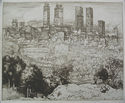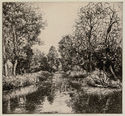
19th, 20th & 21st Century Fine Prints
707-546-7352 · fax 707-546-7924 · web: www.annexgalleries.com · email: artannex@aol.com
Donald Shaw MacLaughlan Biography
Donald Shaw MacLaughlan
Canadian born
1876–1938
Biography
Donald Shaw MacLaughlan was born in Charlottetown, Prince Edward Island, Canada on November 9, 1876. His family moved to Boston, Massachusetts in 1890 where he began to experiment with different art media; watercolor, oil painting and finally, etching – with a few attempts at lithography. He spent much of his early years at the Boston Public Library studying the work of printmakers, from Durer and Rembrandt to the 18th century English, French and Italian masters.
Like many American artists of the time MacLaughlan traveled to Europe to study in Paris, enrolling in the Ecole des Beaux Arts and studied further with Jean Leon Gerome and Jean Paul Laurens. In 1899 he began producing etchings, which became his major interest until his death in 1938. He became acquainted with James NcNeill Whistler (1834-1903) and other artists who created etchings and spent time studying the etchings of Rembrandt van Rijn (1606-1669) and other old masters in the collection of the Bibliothèque Nationale. Both Rembrandt and Whistler would have major influences on his art. In 1900 he created a set of 25 etched views of Paris and in 1901 exhibited two etchings in the Salon de la Société Nationale des Beaux-Arts. He returned to the U.S. in 1903, then went back to Paris the following year.
He traveled extensively in Europe, visiting England, Switzerland, Italy and Spain as well as various locales in France. His etched views of Venice were well-known. MacLaughlan exhibited views of Paris, Rouen, Normandy and Italy in 1906 in a solo show at the American Art Association Galleries in Paris. He also displayed his work in the 1906 exhibitions of the Société Nationale des Beaux-Arts and the Société des Peintres-Graveurs Français. MacLaughlan even instructed other expatriate Canadian artists then living in Paris, most notably Clarence Gagnon and Frank and Caroline Armington. From 1905 to 1914, he lived and worked at Asolo near Venice, Italy.
In 1907 MacLaughlan was selected by the Parisian dealer Alvin-Beaumont to pull impressions from several of Rembrandt’s etching plates, 84 of which Alvin-Beaumont had purchased the previous year. MacLaughlan was a member of the circle of modernist American artists in Paris, and was on the advisory board of the Secessionist group organized by Eduard Steichen (1879-1973) on February 25, 1908, the New Society of American Artists in Paris. A day later Alfred Stieglitz (1864-1946), who had seen impressions MacLaughlan pulled from the Rembrandt plates, opened an exhibition in his 291 Gallery in New York City that included works by MacLaughlan. That year MacLaughlan married Alieen Tillman, a native of Nashville, Tenn. Although his main base was in Europe, MacLaughlan visited the U.S. periodically, worked from studios in New York City in 1911 and 1917, contributed to print exhibitions in this country and was a member of the American Society of Etchers.
San Francisco’s Panama-Pacfic International Exposition showed seven of his prints and awarded him a gold medal. MacLaughlan also won medals in expositions in Buffalo, Leipzig and Rome. He was represented by the Albert Roullier Art Galleries in Chicago, which mounted several exhibitions of his work. London’s Fine Art Society organized an exhibition of some two hundred of his works in 1926.
In 1931 he created a set of twelve etched views of Chicago, and the following year won a prize at the annual exhibition of the Society of Etchers in New York City. During his career he created some three hundred prints. In 1935 he was elected an associate member of the National Academy of Design, New York City, and was elected a full member in 1938, the year he died.
His etchings had little commercial success in the US, probably because of the foreign subject matter and the small edition sizes.
Donald Shaw MacLaughlan died in Marrakesh, Morocco in 1938.










